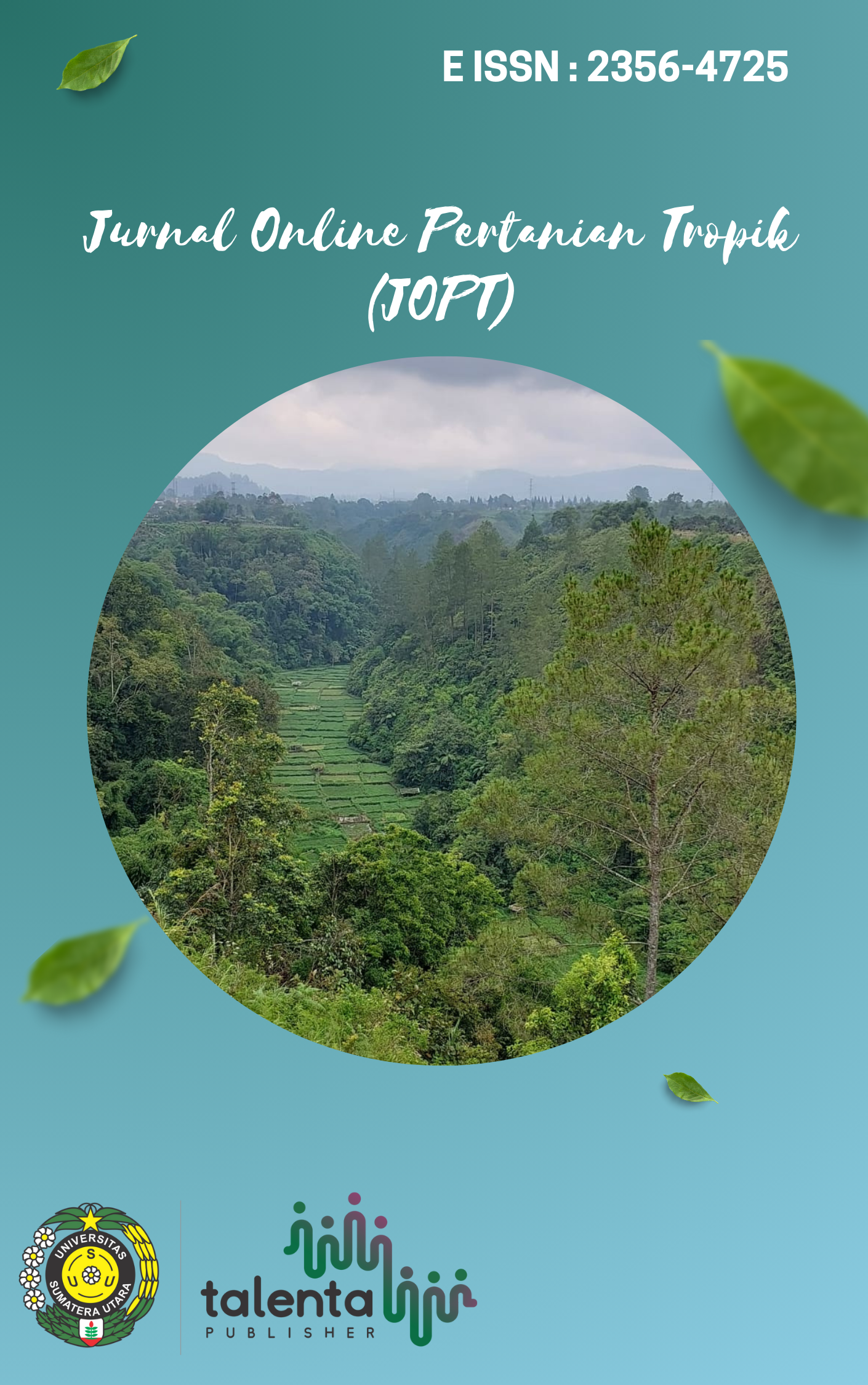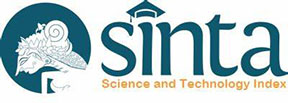CO2 MEASUREMENT IN PALM OIL PLANT IN PEATLAND
DOI:
https://doi.org/10.32734/jopt.v9i2.9225Keywords:
CO2, Palm Oil, PeatAbstract
Peatlands are one of the contributors to greenhouse gas emissions because it is estimated that the carbon stock stored in them is around 528 Giga tons (Gt) or equivalent to 75% of the total carbon (C) in the atmosphere, so that if peat is oxidized it will cause carbon to be released into the air. The conversion of forest land to agricultural land can be one of the causes, including the activity of making drainage channels. The construction of drainage channels causes a decrease in the water table so that the volume of peat under aerobic conditions increases while increasing the activity of microorganisms in decomposing peat. Peat decomposition and root respiration contribute to carbon emissions. This study aims to determine the CO2 concentration in several conditions of oil palm roots. CO2 measurement by survey method on oil palm plantations, using the IRGA (Infra Red Gas Analyzer). Measurements are carried out once per month from January to May 2020 for 3 minutes. The point of observation was determined by 2 factors with 3 treatments and 3 replications. Factor 1 is the observation point in the area of accumulation of midrib pieces and other litter (B1) and factor 2 is the observation point in the road area around the tree (B2). While the treatments were (A1) natural roots, (A2) roots were cut when the measurements were going to be taken and (A3) roots were cut and permanently restricted. The results of the measurement of the highest average concentration of CO2 changes from 0 minutes to 3 minutes in January were in treatment B1A3 (140.4 ppm), February in treatment B2A3 (103.9 ppm), March B1A3 (124.6 ppm) ppm), April B1A3 (143.8 ppm) and May B1A3 (110.7 ppm). Meanwhile, the lowest concentration of CO2 changes from 0 minutes to 3 minutes in January was in treatment B1A1 (71.5 ppm), February in treatment B1A1 (25.7 ppm), March B2A3 (40.2 ppm), and March B2A3 (40.2 ppm). April B2A1 (30.6 ppm) and May B1A1 (43.2 ppm). From the measurement results, it can be concluded that the highest concentration of CO2 and its changes was in treatment B1A3, namely in the treatment of cutting roots with permanent blocks, while the concentration of CO2 and its reduced changes was in the treatment of natural roots (A1) both in Blocks B1 and B2.
Downloads
References
Adiyoga, W. dan T. A. Setiarso, 1999. Strategi Petani dalam Pengelolaan Resiko pada Usahatani Cabai. Jurnal Hortikultura 8(4): 1299-1311.
Anda, M., A. Kasno, dan M. Sarwani. 2010. Sifat dan Kasiat Material Letusan Gunung Merapi untuk Perbaikan Tanah Pertanian. M. Noor, Mamat HS, dan M. Sarwani (eds). Dalam Buku Kajian Cepat Dampak Erupsi Gunung Merapi 2010 terhadap Sumberdaya Lahan Pertanian dan Inovasi Rehabilitasinya. Hal. 87-96. IAARD Press. Badan Litbang Pertanian.
Balitsa Lembang, 2011. Petunjuk Teknis Budidaya Aneka Sayuran. Pusat Penelitian dan Pengembangan Hortikultura. Badan Litbang Pertanian. 121 hal.
Badan Litbang Pertanian, 2014. Rehabilitasi dan Pemulihan Dampak Erupsi Sinabung dan Kelud. http://www.litbang.pertanian.go.id/beri ta/one /1673/5 Maret 2014.
Badan Pusat Statistik Kabupaten Karo, 2015. Kabupaten Karo dalam Angka, 2014. Badan Pusat Statistik Kabupaten Karo.
Direktorat Jendral Perkebunan. 2013. Pedoman Teknis Pengembangan Kelapa Sawit.
Nainggolan, P., 1991. Pengaruh Kalium dan Busukan Ikan terhadap Pertumbuhan dan Produksi Kentang. Jurnal Hortikultura 1(4): 8-13.
Nainggolan, P., 2009. Pemanfaatan Kompos Limbah Sawit pada Tanaman Kentang di Lokasi Primatani Nagalingga Kabupaten Karo. Prosiding Seminar Nasional Pekan Kentang 2008: Peningkatan Produktivitas Kentang dan Sayuran Lainnya dalam Mendukung Ketahanan Pangan , Perbaikan Nutrisi, dan Kelestarian Lingkungan di Lembang 20-21 Agustus 2008. hal. 151-161.
Pusat Penelitian dan Pengembangan Perkebunan [puslitbangun]. 2010. Budidaya dan Pasca Panen Kelapa Sawit. Penerbit ESKA, Jakarta
Saptana., M. Siregar, S. Wahyuni, S.K. Dermoredjo, E. Ariningsih dan V. Darwis, 2005. Pemantapan Model Pengembangan Kawasan Agribisnis Sayuran Sumatera (KASS). Pusat Penelitian dan Pengembangan Sosial Ekonomi Pertanian, Badan Litbang Pertanian. 232 hal.
Tanaka, A., 1980. Source and Sink Relationship in Crop Production. Tech. Bull. 52; 17 p.
Tarigan, A., 2015. Rehabilitasi Lahan Pertanian Tertutup Abu Vulkanik Erupsi Gunung Sinabung. Jurnal Pertanian Tropik. Vol. 2 (3): 220 – 227
Usfal, 2015. Pemberian Cendawan Mikoriza dan Bahan Amelioran pada Tanaman Jagung dan Bawang Daun di Lahan Tercemar Abu Vulkanik Gunung Sinabung Kabupaten Karo. Laporan Hasil Penelitian Smartdy. Badan Litbang Pertanian.
Wahyunto., D. Kuncoro, K. Nugroho, dan M. Sarwani, 2012. Jenis Material Erupsi Gunung Merapi dan Dampaknya terhadap Sumberdaya Lahan. M. Noor, Mamat HS, dan M. Sarwani (eds). Dalam Buku Kajian Cepat Dampak Erupsi Gunung Merapi 2010 terhadap Sumberdaya Lahan Pertanian dan Inovasi Rehabilitasinya. Hal. 25-44. IAARD Press. Badan Litbang Pertanian.
Downloads
Published
How to Cite
Issue
Section
License
Copyright (c) 2022 Jurnal Pertanian Tropik

This work is licensed under a Creative Commons Attribution-ShareAlike 4.0 International License.






















